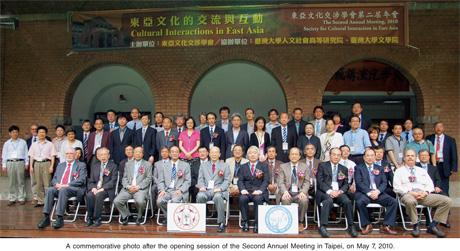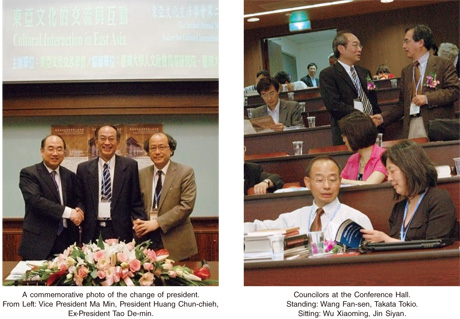Journal of Cultural Interaction in East Asia Vol.2 ―Table of Contents
Preface
| Two Tensions and Their Resolution in Cultural Interaction in East Asia (HUANG Chun-Chieh) | 詳細 |
Special Contribution
| Basic Issues of Cultural Interactions – A European Perspective (Jörn RÜSEN) | 詳細 |
Articles
| The Discovery of the Gold Seal in 1784 and the Waves of Historiography Ever Since (Joshua A. FOGEL) | 詳細 |
| The Development of Naitō Konan’s Progressive View of History: A Point of Convergance with Zhang Xuecheng’s Wenshi tongyi (TAO De-min) | 詳細 |
| Translating Western Concepts by Creating New Characters: A Comparison of Japanese and Chinese Attempts (SHEN Guowei) | 詳細 |
Book Reviews
| Huang Chun-chieh, Higashi Ajia no Jugaku: Keiten to sono kaishaku Reviewed by John TUCKER | 詳細 |
| Jōjin, Xinjiao Can Tiantai Wutai shan ji Reviewed by Robert BORGEN | 詳細 |
| Hongrumong (Korean translation of Hongloumeng), 6 vols., tr. by Yongchul CHOE and Minhee Ko Reviewed by ZHAO Dongmei | 詳細 |
| Huabei nongcun minjian wenhua yanjiu congshu (Research Series on North China Rural Folk Culture), ed. by Daniel L. Overmyer and Fan Lizhu. Reviewed by HUANG Yun | 詳細 |
Introduction of Major Institutions
| East Asian Studies at the Research Institute for Languages and Cultures of Asia and Africa, Tokyo University of Foreign Studies (國立亞非語言文化研究所) |
詳細 |
| Center for Kaitokudō Studies, Osaka University (大阪大學懷德堂研究中心) |
詳細 |
| Research Institute for Oriental Cultures, Gakushuin University (學習院大學東洋文化研究所) |
詳細 |
| The Tsinghua Academy of Chinese Learning (清華大学國學研究院) |
詳細 |
| The Institute of Japanese Culture Studies at Zhejiang Gongshang University (浙江工商大學日本文化研究所) |
詳細 |
| The Centre of Sino-Western Cultural Studies of Macao Polytechnic Institute (澳門理工學院中西文化研究所) |
詳細 |
Reports on the SCIEA and Related News
| -Program of the Second Annual Meeting of the SCIEA, 2010 -Taipei Collection of Japanese Research Series of the Center for Japanese Studies at Korea University |
詳細 |
Contribution Guidelines
| Contribution Guidelines | 詳細 |
Journal for Cultural Interaction in East Asia Vol.2
Preface:Two Tensions and Their Resolution in Cultural Interaction in East Asia
HUANG Chun-Chieh
Basic Issues of Cultural Interactions – A European Perspective
Jörn RÜSEN
The paper concentrates on the issue of ethnocentrism in cultural interaction. It briefly mentions the East Asian case and mainly tackles the European one. It gives examples of ethnocentric attitudes in history, but its main point is presenting examples of overcoming the unbalanced evaluation in expressing cultural identity and difference by means of new forms of generating a sense of history. Examples are discussed as indicators of new approaches to dealing with morality beyond the highly problematic distinction between good and evil along the line of self and other.
 ダウンロード[English](PDF)
ダウンロード[English](PDF)
The Discovery of the Gold Seal in 1784 and the Waves of Historiography Ever Since
Joshua A. FOGEL
According to the Hou Han shu, in 57 B.C.E. an emissary from the land we now call Japan arrived at the court of the Later Han dynasty in Luoyang. Although we don’t know his name or who his sovereign was, he was awarded a seal and ribbon. The seal promptly disappeared from history for the next 1,727 years. It was unexpectedly discovered in an irrigation ditch being repaired by a farmer in Kyushu. For the next 233 years until now, every detail about this golden seal has been the topic of extensive debate with over 350 books and articles devoted to the topic. This essay discusses that lengthy debate and tries to understand it on its own terms.
 ダウンロード[English](PDF)
ダウンロード[English](PDF)
The Development of Naitō Konan’s Progressive View of History: A Point of Convergance with Zhang Xuecheng’s Wenshi tongyi
TAO De-min
An important feature of Naitō Konan’s historiography is his progressive view of history. The development of this progressive view came not only from modern Western scholarship but also from early-modern Chinese and Japanese traditional scholarship. Examples of such Chinese scholarship are Du You’s Tong dian, Zhu Xi’s Zhuzi yu lei, Wang Yinglin’s Kunxue jiwen and Zhang Xuecheng’s Wen shi tong yi, which were all works that Naitō liked to read. This essay will show Naitō’s points of convergence with Zhang Xuecheng’s scholarship, in particular, his advocating that the Six Classics are all historical works, and will evaluate Naitō’s attempts to find spiritual similarities between Chinese and Western scholarship.
 ダウンロード[English](PDF)
ダウンロード[English](PDF)
Translating Western Concepts by Creating New Characters: A Comparison of Japanese and Chinese Attempts
SHEN Guowei
Chinese characters are considered as an adaptable system, open to expansion and revision. Throughout history, the creation of new characters was one of the most important solutions to enlargements of the conceptual repertoire. Both scholars of “Dutch Learning” in Japan and missionaries active in nineteenth- century China used Chinese characters in their translations of western concepts. From a methodological point of view, Japanese scholars mostly coined compound words rendering the literal meanings of their terms of departure while translators in China, invigorated by the success of the new characters devised for chemical elements, believed that drafting new characters was more in line with the characteristics of the Chinese language. However, notwithstanding the painstaking efforts with which they were created, the new characters proposed by missionaries were eventually replaced by compound terms first used in Japanese adaptations. This paper examines the different practices and attitudes of Chinese and Japanese authors toward the creation of new characters as a method of translation. Analyzing the influence of their divergent approaches on the lexical systems of their respective languages, since Chinese has a very limited number of phonetic patterns, I conclude that it is impossible to create viable technical terminologies only by increasing new characters.
 ダウンロード[English](PDF)
ダウンロード[English](PDF)
Book Reviews
-Huang Chun-chieh, Higashi Ajia no Jugaku: Keiten to sono kaishaku Reviewed by John TUCKER-Jōjin, Xinjiao Can Tiantai Wutai shan ji Reviewed by Robert BORGEN
-Hongrumong (Korean translation of Hongloumeng), 6 vols., tr. by Yongchul CHOE and Minhee Ko Reviewed by ZHAO Dongmei
-Huabei nongcun minjian wenhua yanjiu congshu (Research Series on North China Rural Folk Culture), ed. by Daniel L. Overmyer and Fan Lizhu. Reviewed by HUANG Yun
Introduction of Major Institutions
(國立亞非語言文化研究所)-Center for Kaitokudō Studies, Osaka University
(大阪大學懷德堂研究中心)
-Research Institute for Oriental Cultures, Gakushuin University
(學習院大學東洋文化研究所)
-The Institute for Advanced Studies in Humanities and Social Sciences, National Taiwan University
(國立臺灣大學人文社會高等研究院)
-The Tsinghua Academy of Chinese Learning
(清華大学國學研究院)
-The Institute of Japanese Culture Studies at Zhejiang Gongshang University
(浙江工商大學日本文化研究所)
-The Centre of Sino-Western Cultural Studies of Macao Polytechnic Institute
(澳門理工學院中西文化研究所)
Reports on the SCIEA and Related News
-Taipei Collection of Japanese Research Series of the Center for Japanese Studies at Korea University



 English
English 日本語
日本語